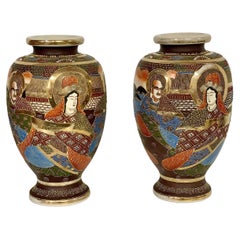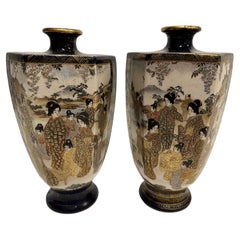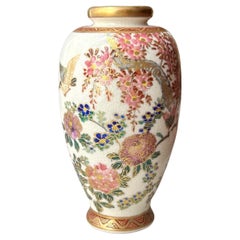Gilt Ceramics
1
2
to
1
1
2
2
2
1
1
2
1
1
2
2
2
2
2
1
1
Creator: Satsuma
Technique: Gilt
Pair of Porcelain Japanese Satsuma 'Moriage' Gilt Vases
By Satsuma
Located in LA CIOTAT, FR
This handsome pair of 20th century glazed and gilded Japanese Satsuma vases, with their vivid, jewel-like colours and elegant baluster-shaped forms, feature the traditional Japanese ...
Category
20th Century Japanese Gilt Ceramics
Materials
Porcelain
Pair of Blue Ground Japanese Satsuma Vases
By Satsuma
Located in Norwood, NJ
These are a very good quality pair of earthenware Japanese Satsuma vases, beautifully hand decorated and from the Meiji period, circa 1880. The vases...
Category
Late 19th Century Japanese Meiji Antique Gilt Ceramics
Materials
Ceramic, Earthenware
Related Items
Satsuma Japanese Meiji Miniature Enameled Teapot Kozon Mark
By Satsuma
Located in Bishop's Stortford, Hertfordshire
An exceptional Japanese Satsuma miniature spool shaped pottery teapot and cover finely hand enameled with Kozon mark and dating from around 1880. This delightful teapot has an invers...
Category
19th Century Japanese Meiji Antique Gilt Ceramics
Materials
Pottery
Meiji Period Diminutive Satsuma Baluster Vase.
By Satsuma
Located in Vero Beach, FL
Meiji Period Diminutive Satsuma Baluster Vase.
This Japanese Satsuma vase from the late Meiji period is hand painted and gilt decorated with a Japanese landscape in exquisite detail...
Category
20th Century Japanese Meiji Gilt Ceramics
Materials
Porcelain
Japanese Antique Satsuma Pottery Buddhist Monks Vase with Shimazu Crest Mark
By Satsuma
Located in Studio City, CA
A beautiful Japanese Satsuma pottery studio vase featuring multiple kesa-clad enlightened Buddhist monks on each side of the vase. The piece is finely detailed with rich raised gilt highlights throughout and beautifully decorated in gold and various hand painted other colors.
From the Meiji period (1868-1912).
This piece has the all-important Shimazu Family crest mark (red circle with a cross inside) on the base authenticating the work as an old and original Satsumaware work. The mark shows the pottery was made under the rule of the Shimazu clan.
From a Los Angeles Collection...
Category
Early 20th Century Japanese Meiji Gilt Ceramics
Materials
Earthenware, Pottery
H 11.5 in W 4.5 in D 4.5 in
Antique Japanese Meiji Satsuma Painted Vase
By Satsuma
Located in LA CIOTAT, FR
A petite and beautiful hand-decorated ceramic baluster vase, painted all around with traditional Japanese motifs, including native flora, birds and bamboo stems on a creamy glazed background. The colour palette is bold and bright, with highlights of green, red and blue, together with plentiful gilt relief...
Category
19th Century Japanese Meiji Antique Gilt Ceramics
Materials
Ceramic
Japanese Satsuma Vases, Pair
By Satsuma
Located in New York, NY
A gorgeous pair of Japanese earthenware Satsuma vases, hand-painted, Meiji period, circa early-20th century, Japan. Vases' beautiful decoration is high-qu...
Category
Early 20th Century Japanese Meiji Gilt Ceramics
Materials
Earthenware
Antique Meiji Period Satsuma Shimazu Vases - a Pair
By Satsuma
Located in Seguin, TX
Circa 1900 pair of Satsuma vases. Hand painted coastal landscape, mountains, women and children outside of elaborate homes. Signed on the bottom with the Shimazu Clan crest, wear to...
Category
Early 20th Century Japanese Meiji Gilt Ceramics
Materials
Ceramic
Japanese Meiji Period Satsuma Large Square Bowl Centerpiece
By Satsuma
Located in Vero Beach, FL
Japanese Meiji Period Satsuma large square bowl
Antique early Meiji Period 15" square with scalloped rim Satsuma bowl. Highly unusual and finely painted. ...
Category
19th Century Japanese Meiji Antique Gilt Ceramics
Materials
Ceramic
19th Century Japanese Satsuma Porcelain Water Well Bucket, Wishing Well Vase
By Satsuma
Located in Vero Beach, FL
This Japanese porcelain vase is barrel shaped with a yolk handle. It is both finely and intricately hand painted. It pictures groups of scholars with scrolls dressed in elaborate brocade kimonos...
Category
Late 19th Century Japanese Meiji Antique Gilt Ceramics
Materials
Porcelain
H 5 in W 4.13 in D 4.13 in
Satsuma Earthenware Vase, by Kinkozan, Japanese, Meiji Period
By Satsuma
Located in West Palm Beach, FL
A Satsuma Earthenware Vase,
by Kinkozan,
Japanese, Meiji period (1868-1912)
decorated in polychrome enamels and gilt over a clear, crackled glaze, delicately painted with ladies and men, the reverse with a flowering garden with sprays of flowers, the neck with geometric and floral designs, a band of kifu heads in silver and gilt above the foot, on a midnight-blue ground, signed Kinkozan zo...
Category
1860s Antique Gilt Ceramics
Materials
Earthenware
Antique Japanese Satsuma Miniature Cabinet Vase
By Master Ryozan
Located in Philadelphia, PA
A fine diminutive, antique Japanese Satsuma pottery cabinet vase.
Decorated throughout with gilding and raised enamel.
There are...
Category
20th Century Japanese Meiji Gilt Ceramics
Materials
Ceramic
Antique Japanese Satsuma Pottery Bud Vase
By Makuzu Kozan
Located in Philadelphia, PA
A fine antique Japanese Satsuma pottery vase.
In the form of a bud vase with a round base and narrow, tapered neck.
Decorated throug...
Category
Early 20th Century Japanese Meiji Gilt Ceramics
Materials
Pottery
Early Japanese Satsuma Antique Vase
By Satsuma
Located in Atlanta, GA
An Satsuma ceramic stone ware vase, circa 19th century, around the end of the Edo and the beginning of Meiji period. In the form of a Classic garlic bottle whose prototype was from China, the white bodied piece is decorated with an early form of kin nishikide, the so called golden brocade, a palette of iron-red, blue, green, yellow, purple and black with golden highlight. The over glazed enamel paint shows a group of robed figures in a garden setting with a lion and three tigers. A transparent overall glaze shows very fine crackles. The design is relatively sparse with plenty of negative space in contrast to the Satsuma production from the late 19th century, when the trend became fussy and overly glitz, due to the influence by the perceived western taste for the export market. This piece may still be made for export but its pattern was more influenced by both Kyoto Pottery and the Kano school of painting compared to the export ware by the end of the 19th century onward to the early 20th century. It was believed by many that this was a result of Satsuma potters visiting Kyoto in the late seventeenth century to learn over glaze painting techniques.
There are some age glaze crackles especially around the foot. The piece is not signed in keeping with the earlier production before Satsuma ceramics...
Category
Mid-19th Century Japanese Japonisme Antique Gilt Ceramics
Materials
Ceramic
Recently Viewed
View AllMore Ways To Browse
Green Asian Pottery
Antique Bats
Bats Antique
Antique Green Chinese Pottery
Chinese Republic Period
Chinese Antique Seal
Antique Famille
Japanese Floral Panel
Japanese Porcelain Charger
Asian Antique Jars
Asian Fruit
Asian Foo Dog
Chinese Blue White Dragon
Asian Blue Bowl
Chinese Blue And White Dragon
Chinese Blanc
Famille Rose Qing Porcelain
Song Dynasty



